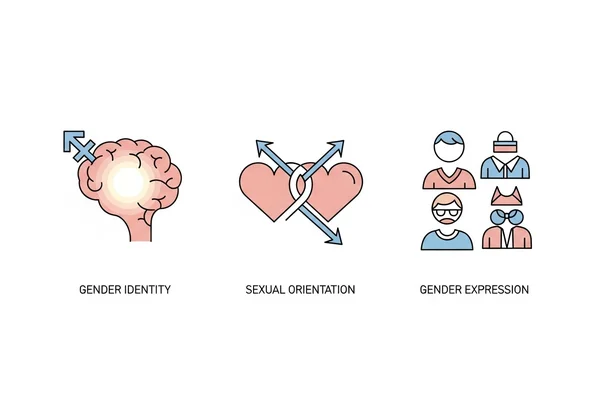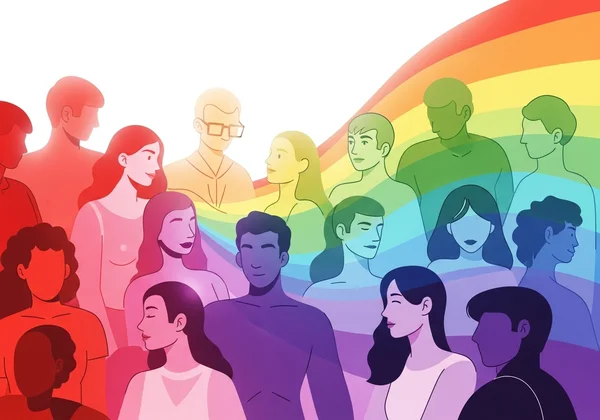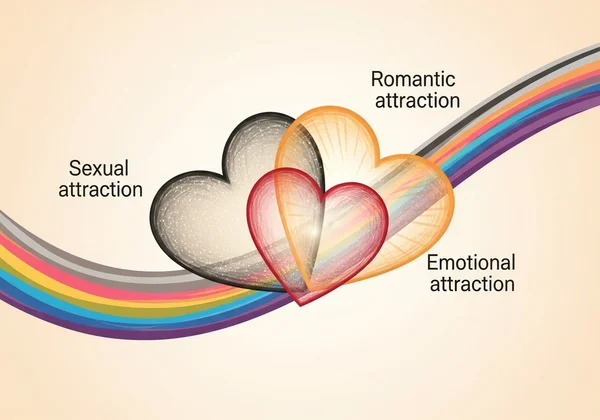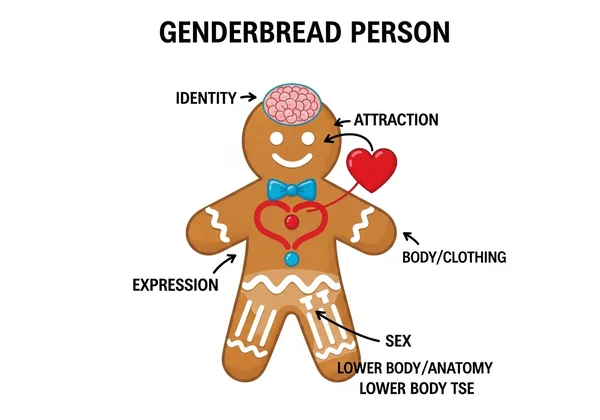Identiti Jantina lwn. Orientasi Seksual: Panduan Jelas Sebelum Kuiz Gay Anda
Adakah anda berasa sedikit keliru dengan istilah seperti "identiti jantina," "orientasi seksual," dan "ekspresi jantina"? Anda tidak keseorangan! Ramai orang menggunakan perkataan ini secara bergantian, tetapi ia merujuk kepada bahagian diri kita yang berbeza dan penting. Memahami perbezaan identiti jantina lwn orientasi seksual adalah langkah asas dalam meneroka diri dan menyokong orang lain. Pernahkah anda terfikir apa sebenarnya maksud istilah ini? Panduan ini akan menerangkan konsep-konsep ini dengan mudah dan jelas, membantu anda menavigasi dunia identiti yang pelbagai dengan keyakinan dan mula meneroka identiti anda dengan lebih jelas.

Apakah Identiti Jantina? Meneroka Siapa Diri Anda dalam Perjalanan Anda
Identiti jantina adalah perasaan dalaman diri anda yang mendalam. Ia adalah tentang siapa anda tahu diri anda di dalam—sama ada lelaki, perempuan, gabungan kedua-duanya, atau tidak kedua-duanya. Perasaan ini sama sekali berasingan daripada jantina semasa lahir dan tidak ada kena mengena dengan siapa anda tertarik. Ia adalah kebenaran peribadi, bahagian teras identiti individu anda.
Ia sering digambarkan sebagai pemahaman paling mendalam anda tentang diri sendiri. Ia bukan tentang bahagian tubuh atau jangkaan masyarakat; ia adalah tentang diri anda yang tulen. Mengiktiraf dan menghormati identiti jantina anda adalah tindakan penerimaan diri yang kuat.
Ia Tentang Perasaan Dalaman Diri Anda, Bukan Tarikan
Satu perkara yang sering mengelirukan adalah mencampuradukkan identiti jantina dengan orientasi seksual. Perbezaan utama ialah identiti jantina adalah tentang siapa anda, manakala orientasi seksual adalah tentang siapa yang anda tertarik. Contohnya, seorang lelaki (identiti jantina) boleh tertarik kepada lelaki lain (orientasi seksual), wanita, atau orang dari mana-mana jantina.
Perasaan dalaman diri anda adalah perjalanan peribadi. Ia tidak menentukan perasaan romantis atau seksual anda terhadap orang lain. Memisahkan kedua-dua konsep ini adalah langkah pertama dan paling penting ke arah memahami kerumitan indah identiti manusia.
Meneroka Identiti Jantina yang Pelbagai: Melangkaui Cisgender dan Maknanya untuk Identiti LGBTQ+
Dunia jantina adalah spektrum yang kaya, bukan binari yang mudah. Walaupun ramai orang mengenal pasti sebagai "cisgender"—bermaksud identiti jantina mereka selaras dengan jantina semasa lahir—ramai yang lain tidak. Di sinilah kita menemui kepelbagaian identiti yang indah.
Istilah seperti "transgender" menggambarkan seseorang yang identiti jantinanya berbeza daripada jantina semasa lahir. "Non-binary" adalah istilah payung untuk identiti yang berada di luar binari lelaki/perempuan yang ketat. Terdapat banyak identiti lain juga, setiap satu sah. Memahami kepelbagaian ini membantu mewujudkan dunia yang lebih inklusif dan menerima untuk semua orang.

Apakah Orientasi Seksual? Siapa yang Anda Tarik
Sekarang, mari kita alihkan fokus kepada apakah orientasi seksual. Konsep ini menerangkan kecenderungan tarikan emosi, romantis, dan/atau seksual seseorang terhadap orang lain. Tidak seperti identiti jantina, yang berkaitan dengan hubungan anda dengan diri sendiri, orientasi seksual adalah tentang hubungan dan kaitan anda dengan orang lain.
Ia adalah bahagian penting dalam diri anda, walaupun bagi sesetengah orang, ia boleh menjadi fleksibel dan berubah dari semasa ke semasa. Menyoal dan meneroka tarikan anda adalah sebahagian daripada pengalaman manusia yang benar-benar normal. Jika anda ingin tahu di mana anda mungkin berada dalam spektrum ini, kuiz seksualiti yang sulit boleh menjadi alat yang berguna untuk refleksi diri.
Tarikan Romantis, Seksual, dan Emosi Dijelaskan
Tarikan bukanlah satu perasaan yang mudah. Ia boleh dipecahkan kepada jenis yang berbeza, yang tidak selalu selaras dengan sempurna. Memahami nuansa ini boleh membawa banyak kejelasan kepada perasaan anda.
- Tarikan Seksual: Ini adalah keinginan untuk hubungan seksual dengan orang lain.
- Tarikan Romantis: Ini adalah keinginan untuk hubungan romantis dengan orang lain, melibatkan keintiman emosi dan kaitan.
- Tarikan Emosi: Ini adalah keinginan untuk menjadi rapat secara emosi dengan seseorang, berkongsi perasaan dan pengalaman tanpa semestinya romantis atau seksual.
Bagi kebanyakan orang, tarikan ini selaras. Tetapi bagi sesetengah orang, seperti mereka yang mengenal pasti sebagai aseksual atau aromantik, mereka mungkin mengalami satu jenis tarikan tanpa yang lain.
Spektrum Orientasi: Gay, Biseksual, Panseksual, dan Banyak Lagi
Sama seperti jantina, orientasi seksual wujud dalam spektrum yang luas. Anda mungkin pernah mendengar istilah umum, tetapi terdapat pelbagai identiti yang wujud. Berikut adalah beberapa contoh utama:
- Gay/Lesbian: Tarikan kepada orang dari jantina yang sama.
- Biseksual: Tarikan kepada lebih daripada satu jantina (sering kepada lelaki dan wanita).
- Panseksual: Tarikan kepada orang tanpa mengira identiti jantina mereka.
- Aseksual: Mengalami sedikit atau tiada tarikan seksual kepada orang lain.
Meneroka definisi ini boleh membantu anda mencari bahasa yang paling sesuai dengan pengalaman peribadi anda. Jika anda bertanya kepada diri sendiri, "Adakah saya gay?", ingatlah bahawa anda berada di ruang yang selamat untuk meneroka soalan itu. Kuiz adakah saya gay direka untuk menjadi titik permulaan untuk penerokaan peribadi itu.

Ekspresi Jantina: Bagaimana Anda Mempersembahkan Diri Anda kepada Dunia
Bahagian ketiga teka-teki ini ialah ekspresi jantina. Ini adalah bagaimana anda secara luaran mempersembahkan jantina anda kepada dunia. Ia termasuk pilihan pakaian, gaya rambut, tingkah laku, suara, dan nama atau kata ganti nama anda. Ia adalah cara anda menyampaikan identiti anda kepada orang lain.
Yang paling penting, ekspresi jantina anda tidak semestinya "sepadan" dengan identiti jantina atau orientasi seksual anda secara stereotaip. Seorang lelaki boleh mempunyai ekspresi feminin, seorang wanita boleh mempunyai ekspresi maskulin, dan seseorang bukan-binari boleh menyatakan diri mereka dalam apa jua cara yang terasa tulen. Ekspresi adalah satu bentuk kreativiti dan kebebasan peribadi.
Melangkaui Stereotaip: Maskulin, Feminin, Androgin, dan Lancar
Kita sering diajar bahawa hanya ada dua cara untuk menyatakan jantina: maskulin atau feminin. Walau bagaimanapun, ekspresi jantina jauh lebih lancar dan pelbagai. Sesetengah orang mempunyai ekspresi androgin, yang menggabungkan elemen maskulin dan feminin atau bersifat neutral jantina.
Yang lain mungkin mendapati ekspresi mereka lancar, berubah dari hari ke hari berdasarkan bagaimana perasaan mereka. Tiada cara yang betul atau salah untuk menyatakan diri anda. Perkara yang paling penting ialah ekspresi anda terasa benar kepada anda, bebas daripada tekanan stereotaip masyarakat.
Menghubungkan Titik: Bagaimana Jantina, Orientasi & Ekspresi Bersilang (dan Berbeza)
Mari kita satukan semuanya. Bayangkan anda mempunyai tiga dail yang berbeza di dalam diri anda: satu untuk Identiti Jantina (siapa anda), satu untuk Orientasi Seksual (siapa yang anda tertarik), dan satu untuk Ekspresi Jantina (cara anda menampilkan diri). Setiap dail ini boleh ditetapkan kepada kedudukan yang berbeza, dan ia beroperasi secara bebas antara satu sama lain.
Seseorang boleh menjadi wanita transgender (identiti jantina) yang lesbian (orientasi seksual) dan mempunyai ekspresi jantina maskulin. Orang lain boleh menjadi lelaki cisgender (identiti jantina) yang biseksual (orientasi seksual) dan mempunyai ekspresi androgin. Kombinasinya tidak berkesudahan, dan setiap satu adalah sah sepenuhnya. Memahami ini membantu melangkaui stereotaip yang berbahaya, seperti idea yang salah bahawa semua lelaki gay mesti feminin.
Mengapa Konsep Ini Sering Keliru (dan Mengapa Ia Penting)
Masyarakat sering menggabungkan konsep-konsep ini, mencipta kategori yang sempit yang tidak mencerminkan realiti. Kita diajar bahawa jika anda diberikan jantina lelaki semasa lahir, anda harus mengenal pasti sebagai lelaki, menyatakan diri anda secara maskulin, dan tertarik kepada wanita. Penyederhanaan yang berlebihan ini mengabaikan pengalaman ramai orang LGBTQ+ dan mewujudkan tekanan berbahaya untuk mematuhi.
Memisahkan konsep-konsep ini adalah tindakan pemberdayaan. Ia memberikan anda—dan semua orang lain—kebebasan untuk menjadi diri anda yang tulen. Ia membolehkan pemahaman yang lebih penyayang dan tepat tentang kepelbagaian manusia. Bagi mereka yang baru memulakan perjalanan mereka, mendapatkan kejelasan ini adalah langkah pertama sebelum menggunakan alat dalam talian untuk merenung bahagian tertentu, seperti tarikan.
The Genderbread Person: Visual Mudah untuk Membimbing Pemahaman Anda
Sumber yang amat berguna untuk menggambarkan perbezaan ini ialah model "Genderbread Person". Grafik mudah ini memecahkan identiti kepada empat bidang utama:
- Identiti (dalam otak): Siapa yang anda tahu anda.
- Tarikan (dalam hati): Siapa yang anda tertarik secara romantis dan seksual.
- Ekspresi (badan/pakaian): Bagaimana anda mempersembahkan jantina anda.
- Jantina Biologi (dalam anatomi): Jantina yang diberikan semasa lahir.
Alat visual ini memudahkan pemahaman bagaimana setiap komponen adalah berbeza dan boleh wujud dalam mana-mana kombinasi. Ia adalah peringatan yang kuat bahawa identiti adalah kompleks dan sangat peribadi.

Menerima Diri Anda yang Tulen: Meneruskan Perjalanan Anda dengan Kejelasan
Memahami perbezaan antara identiti jantina, orientasi seksual, dan ekspresi jantina adalah lebih daripada sekadar pelajaran kosa kata—ia adalah alat untuk empati dan kesedaran diri. Anda kini mempunyai rangka kerja yang lebih jelas untuk memahami diri anda dan orang di sekeliling anda. Pengetahuan ini memperkasakan anda untuk bertanya soalan yang lebih spesifik dan mencari sumber yang benar-benar sesuai dengan perjalanan anda.
Perlu diingat, meneroka identiti anda adalah satu proses, bukan destinasi. Bersabar dan berbaik hati dengan diri sendiri. Jika fokus utama anda sekarang adalah memahami tarikan anda, perjalanan anda untuk merenung diri baru sahaja bermula. Bersedia untuk mengambil langkah seterusnya dalam ruang yang selamat dan peribadi? Mulakan kuiz gay anda sekarang dan dapatkan pandangan tentang perasaan anda.
Soalan Lazim Mengenai Identiti & Orientasi
Adakah kuiz gay boleh menentukan identiti jantina saya?
Tidak, ia tidak boleh. Kuiz gay direka khusus untuk membantu anda merenung corak tarikan anda, yang berkaitan dengan orientasi seksual anda. Identiti jantina anda adalah kesedaran diri dalaman anda, yang hanya anda boleh tentukan. Alat kami memberi tumpuan kepada membantu anda meneroka siapa yang anda tertarik, bukan siapa anda.
Adakah menjadi transgender sama dengan menjadi gay?
Ini sering disalah faham, tetapi ia sangat berbeza. Menjadi transgender berkaitan dengan identiti jantina—ia bermakna jantina dalaman anda tidak selaras dengan jantina semasa lahir. Menjadi gay berkaitan dengan orientasi seksual—ia bermakna anda tertarik kepada orang dari jantina yang sama. Seseorang transgender boleh menjadi gay, heteroseksual, biseksual, atau mana-mana orientasi lain.
Adakah normal untuk menyoal identiti jantina atau orientasi seksual saya?
Sudah tentu. Menyoal adalah sebahagian daripada penemuan diri yang benar-benar normal dan sihat untuk orang dari semua peringkat umur. Ramai orang meneroka perasaan mereka tentang identiti dan tarikan pada suatu ketika dalam hidup mereka. Ia adalah tanda introspeksi dan rasa ingin tahu, dan platform seperti kami wujud untuk menyediakan ruang yang selamat untuk proses penerokaan itu. Anda sentiasa boleh memulakan perjalanan anda secara tanpa nama.
Di mana saya boleh mencari lebih banyak sumber mengenai identiti LGBTQ+?
Mencari maklumat yang boleh dipercayai adalah amat penting. Bermula dengan organisasi LGBTQ+ yang bereputasi seperti The Trevor Project atau GLAAD adalah langkah yang hebat. Selain itu, blog kami menyediakan artikel sokongan dan pendidikan untuk membantu anda sepanjang perjalanan. Pembelajaran berterusan adalah salah satu cara terbaik untuk menyokong diri sendiri dan orang lain.